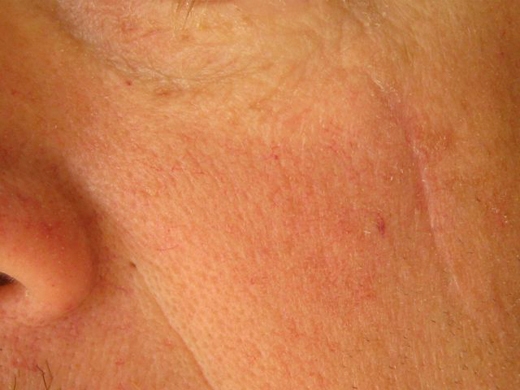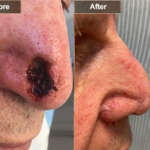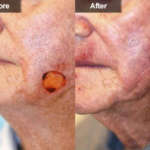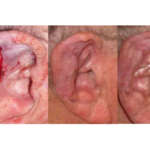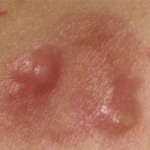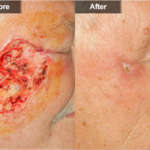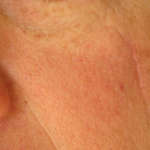Mohs Surgery (Micrographic)
Mohs or Microscopically Controlled Surgery:
Mohs surgery was developed by Dr. Frederick Mohs in the 1940’s as a more precise way to remove skin cancers.
Originally, chemicals were applied to the skin and the entire surgical procedure could take several days. The technique has been refined over the years to the point where the skin cancer is now removed and examined under the microscope for any remaining tumor almost immediately. The basic principle behind the Mohs’ technique is to remove the entire skin cancer without taking any more normal skin than is absolutely necessary. Often times what can be seen on the skin surface only represents a part of the actual skin cancer. “The tip of the iceberg” so to speak. We can not see the “roots” of the skin cancer that are under and around the skin cancer, the microscope is used to trace out and map the exact extent of the tumor. The surgeon may then remove only the cancerous tissue. This prevents either removing too little, leaving tumors behind to come back or recur (usually larger) in the future, or from removing too much and creating a larger than necessary wound. In essence, the best of both worlds is achieved. The entire skin cancer is removed and as much as possible of the normal skin is preserved. The Mohs’ microscopically controlled technique offers a cure rate of 98-99%, the highest of any technique available.
Since Mohs’ surgery requires higher trained personnel, and can be time consuming, it is reserved only for certain cases. The three most common indications for using Mohs’ technique are 1) when the tumor is located on the structure that is so important that one wishes to remove only the diseased tissue and preserve as much of the normal skin as possible, 2) when the cancer has been previously treated and has come back (recurrence) and 3) in an area of the body where it is not effectively curable with other methods.
We know that you must have many questions about your skin cancer diagnosis and treatment, and we hope that this information will assist you by answering some of the common questions that are asked by patients below.
If you believe you have symptoms of skin cancer, seek medical treatment as soon as possible, as early detection is important in receiving effective treatment.Request an appointment at one of our two locations in Northern Virginia: Mclean. or Woodbridge.
Skin Cancers:
Skin cancer is the most common form of all cancers. Over one million new cases of skin cancer will be diagnosed in the United States this year alone. The three most common types of skin cancer are 1) basal cell carcinoma (the most common and least dangerous), 2) squamous cell carcinoma and 3) melanoma (the least common but the most dangerous type). These names come from the name of the type of cell that becomes cancerous, a basal cell, a squamous cell or a melanocyte.
Cancer is a very frightening word that is used to describe many very different diseases with many very different prognoses. A cancer simply means that a cell is replicating faster than it normally should. Most cells that make up the body to grow replace worn-out tissue and repair injuries. If one of these cells is injured in some way (for example, by the sun in skin cancers) and becomes cancerous, it begins to replicate and divide more quickly. With the cell dividing more rapidly, the body is unable to process
all of the new cells and a mass or ball of these cells is formed. This mass of new cells is called a tumor.
In some tumors, the cells may break away from the mass, travel in the blood or lymphatic stream and set up in another part of the body and continue growing and invading the tissue. This process is called metastasizing, and is associated with the more dangerous forms of cancer. This almost never occurs in basal cell carcinomas and is rare in squamous cell carcinomas that are smaller than two centimeters in width. Melanoma is more likely to metastasize and spread to other parts of the body such as the lungs, liver and bones.
Basal Cell Carcinomas:
Basal cell carcinoma is the most common form of all cancers in this country. It accounts for approximately 75% of all skin cancers and of the three skin cancers listed above has the best prognosis. Although they are typically seen in the sun exposed areas of fair skinned middle to older aged adults, basal cell carcinomas are being seen more and more frequently in the younger population. The name is derived from the type of cell in the skin that has become cancerous – the basal cell. Basal cells line the base, or bottom, of the uppermost layer of the skin, the epidermis. When one of these cells is damaged (by exposure to the sun or other form of radiation) and begins to grow and replicate more rapidly than it normally does, it is called a basal cell carcinoma.
Basal cell carcinomas generally start at one particular spot and very slowly grow, out and downward in the skin. The true size and extent of skin cancers cannot be fully appreciated by simply looking at the surface of the skin. In fact, the skin cancer has usually been growing for several months beneath the skin before it surfaces and can be seen by the naked eye. Only under microscopic examinations is it possible to determine the extent of the tumor. Often times, if the tumor is very small, the biopsy may remove most of the skin cancer and the skin may appear very normal on the surface. Unfortunately, there are usually tumor cells beneath this normal appearing skin that are continuing to replicate and grow. On the other hand, some basal cell carcinomas may be quite large. Although, it is extremely unusual for basal cell carcinoma to metastasize, if left untreated these tumors will continue to grow to very large sizes and may invade bone and other tissue beneath the skin.
Squamous Cell Carcinomas:
Squamous cell carcinomas, especially when they are larger than 2cm in width, can be more serious disease than basal cell carcinomas. The normal squamous cells are located in the upper and middle part of the most superficial layer of the skin, the epidermis, and tend to be more aggressive when they become cancerous. These skin cancers usually grow more quickly and are more likely to invade structures beneath the skin and may metastasize to other parts of the body. Still only approximately 5% of squamous cell carcinomas usually appear as rough scaly red spots on the skin. Unfortunately, as with basal cell carcinomas, it is very difficult to judge the size and extent of the skin cancer by simply looking at the skin surface. Skin cancers often grow under what appears to be normal skin to the naked eye.
Malignant Melanoma:
This is potentially the most serious form of skin cancer. Malignant melanoma generally appears as a brown or black patch; with shades of red or purple in it. They may arise on their own or develop in a pre-existing mole. There were over 56,000 cases annually in the US. If the tumor is limited to the top layer of the skin (know as the epidermis) the cancer is called Malignant Melanoma in Situ or MMIS for short. MMIS has an excellent prognosis with near 100% survival. Since invasive melanoma is not often treated with the microscopically controlled or Mohs surgery, it will not be discussed further in this text. All information in this brochure refers to basal and squamous cell carcinomas, and malignant melanoma in situ.
Why do people get skin cancers?
Although, we do not know all of the factors that cause skin cancer, excessive exposure to sunlight is the single most important factor in the formation of skin cancer. Other forms of radiation, such as ultraviolet light therapy (including sun tanning beds) or x-ray therapy, may also contribute to the formation of skin cancers. Over time (many years), a normal basal or squamous cell may be transformed into a cancerous cell. As a cancerous cell, it will begin to divide more rapidly than the body is used to, and a collection of that type of cell will form. This collection of cells is known as a tumor.
Skin cancers occur more frequently in people with fair complexions (blonde hair, blue eyes), individuals of Celtic decent and those exposed to more than average amounts of sun. Darker skinned individuals, who have more pigment to shield their skin from the harmful rays of the sun rarely form skin cancers. Although the effects of the sun’s rays are cumulative, there is usually many years separating the significant exposure to the sun and the formation of skin cancer. The majority of sun exposure generally occurs during the teenage years and early twenties, while most skin cancers do not begin to occur until the forties.
The best way to protect yourself from future skin cancers is to make a serious attempt at reducing the amount of sun light you are exposed to. You should always apply a sun screen with a Sun Protection Factor (SPF) of 15 or greater whenever you will be exposed to the sun, wear a broad rimmed hat, and limit you exposure to the sun during the mid-day (10am to 3pm), when the sun’s rays are the most intense. You do not have to change your entire lifestyle, just alter it intelligently and take the proper precautions. An unfortunate statistic is that 50% of people who develop a basal cell carcinoma will develop another one within 5 years.
Treatment of Skin Cancers:
Skin cancer may be effectively treated by several methods. The most common ways include electrodessication and curettage (scraping and burning), cryotherapy (freezing), radiation therapy (X-rays), traditional excisional surgery and Mohs’ or microscopically controlled surgery. The treatment of each skin cancer must be individualized, taking into account the type, size and location of the cancer, the patient’s age and whether or not the cancer has been treated before. Of all forms of treatments for skin cancers, Mohs microscopically controlled surgery has the highest cure rate.
Photo Gallery
Frequently Asked Questions
Although we do not know all of the factors that cause skin cancer, perhaps the most single principal factor is excessive exposure to sunlight.
Skin cancers occur more frequently in persons with fair complexions, particularly those of European descent, specifically Celtic, Germanic, in those who have blonde hair and blue eyes, in persons exposed to more than average amounts of sun, and in persons who have used tanning beds. Darker skinned persons have more pigment, which shields their skin from sunlight to a greater degree, and more rarely have skin cancer. It may take many years to develop skin cancer.
Skin cancer is the most common form of all cancers, with over five million new cases diagnosed annually in the United States. One in five Americans will develop skin cancer by age 70.
“Cancer” is a word used to describe many different diseases in many areas of the body. It simply means that a cell is replicating faster than it normally should. Most body cells naturally grow to replace worn-out tissue and to repair injuries. If one of these cells is injured in some way (for example, by the sun in skin cancers), it begins to replicate and divide more quickly. Because the body is unable to process all of the new cells, a mass or ball of these cells is formed, called a “tumor.”
In some tumors, the cells may break away from the original mass, and travel in the blood or lymphatic stream, then establish themselves in another part of the body and continue growing and invading tissue. This process is called “metastasizing,” and is associated with the more dangerous forms of cancer. This can happen in the more serious types of skin cancer, but rarely in the more common types.
The three types of skin cancer are: basal cell, squamous cell and melanoma. They differ in frequency, location, appearance, and growth patterns.
Basal cell carcinoma: A basal cell is a type of cell found in the bottom of the uppermost layer (epidermis) of the skin. Growth of one of these cells may be triggered by sun exposure or radiation and become a basal cell carcinoma. This is the most common form of all skin cancers and accounts for approximately 75% of all skin cancers.
Of the three types of skin cancer, basal cell has the best prognosis. Although traditionally they were seen in middle-aged to older adults, they are now being seen more and more in the younger population and early adults.
These cancers generally develop at one particular spot and very slowly grow out and downward in the skin. The true size and extent cannot be fully appreciated by simply looking at the skin’s surface. Microscopic examination is necessary to determine the extent of the tumor. Often, if the tumor is very small, a biopsy may remove most of it and the skin may appear normal on the surface. Sometimes, however, cells beneath the skin may continue to replicate and grow. Some of these carcinomas may be quite large. If left untreated, these tumors may grow to a very large size and invade bone and other tissue beneath the skin and, rarely, metastasize.
Squamous cell carcinoma: This type is more serious than basal cell carcinomas, as they are more aggressive. Normal squamous cells are located in the upper and middle part of the most superficial layer of the skin. Squamous cell carcinomas are more likely to invade structures beneath the skin and may metastasize to other parts of the body. It is often very difficult to judge the real size and extent simply by the appearance on the skin’s surface. Skin cancers can grow under what appears to be normal skin to the naked eye, and microscopic examination is very important.
Melanoma: Melanoma is the most serious form of skin cancer, generally appearing as a brown or black patch with shades of red or purple in it. These lesions may arise on their own or may develop in a pre-existing mole. Over 178,000 cases occur annually in the United States.
Skin cancer can be effectively treated by several methods, and is individualized based on the type, size and location of the cancer, the patient’s age and immune status, and whether or not the cancer has been treated before.
The basic principle of Mohs microscopically controlled surgery is that the entire skin cancer is removed without taking any more normal skin than is absolutely necessary. This approach offers the highest cure rate available, usually 98-99%.
The Mohs technique is named after Dr. Frederick Mohs who in the 1940’s developed this more precise method of removing skin cancers. Originally, zinc-based chemicals were applied to the skin, and the entire surgical procedure took several days. Over the years, this method has now been refined to the point where the skin cancer is removed and the tissue is immediately examined under a microscope to look for any remaining evidence of tumor.
Because Mohs surgery requires specially trained personnel and requires more intricate and precise methods, it can be time consuming and is reserved only for certain cases. Some of the most common indications are:
- Cancer located on a body structure that is so important that one wishes to remove only the diseased tissue and preserve all other normal skin.
- Cancer has been previously treated and has recurred.
- The affected area is not effectively curable with other methods.
- Cancers occurring in immuno-compromised patients (kidney, heart, lung, or other solid organ transplant recipient) and patients on medications that suppress the immune system.
A list of medications to avoid is provided. Please check this list. Some medications are not to be taken for two weeks prior to surgery. Others should not be taken for 24 hours prior to your procedure. Please carefully review the following precautions:
- Fourteen days prior to surgery. Do not take aspirin or any aspirin-containing products. If a physician has specifically placed you on aspirin, we will require a letter from your doctor stating that you may stop the aspirin before surgery. In this case, do not stop the aspirin prior to obtaining your doctor’s approval.
- Other pain medications such as Ibuprofen (Motrin/Advil) and Aleve should be avoided for five days prior to surgery.
- You may take Tylenol (Acetaminophen), Datril, Darvocet, Darvon, or Percocet if needed for pain relief.
- Coumadin: If you are taking Coumadin or Warfarin, please check with your prescribing doctor to see if it is safe for you to stop this for your surgery and have that doctor give you specific instructions for stopping and restarting this medication. If you cannot stop Coumadin, please have your blood drawn at your physician’s office to check that your Coumadin level is in the correct range and have them notify our office with the results.
- If you are on Lovenox, Xarelto, Eliquis, or Fragmin, please check with your doctor’s office and have them inform us if it is safe for you to discontinue this medication for your surgery, and give you (and us) the written instructions for stopping and restarting this medication.
- Take all of your other usual medications unless otherwise directed by your physician.
- If you have any questions about your meds, or if they are blood thinning agents, do not hesitate to call our office (Woodbridge: 703-497-1114; McLean: 703-893-1114).
- Do not drink any alcohol for four days prior to surgery (it thins the blood and causes more bleeding).
- Aleve
- Anacin
- Anaprox
- Asaphen
- Ascripin
- Aspirin and baby Aspirin
- Bayer Aspirin
- BC powder and tablets
- Bufferin
- Chondroitin
- Darvon’s Compound (clopidogrel)
- Doan’s Pills
- Echinacea
- Ecotrin
- Empirin
- Excedrin
- Feldene
- Feverfew
- Fiorinal
- Fish oil
- Garlic supplements
- Gingko biloba
- Ginseng
- Herbs and supplements
- Ibuprofen
- Indocin
- Motrin
- Multivitamins
- Naprosyn
- Norgesic
- Nuprin
- Pepto Bismol
- Percodan
- Persantine
- plavix
- Robaxisal
- Soma Compound
- Synalgos DC
- Talwin
- Ticlid
- Vioxx
- Vitamin E
- Zorprin
- Get plenty of rest the night before.
- Eat a good breakfast on the morning of your surgery.
- Bring any book, magazine, or screen device that you might like to read/ use during the various waiting periods that will be required.
- Also, bring any snacks or drinks for waiting periods.
- Wash your hair either the night before or the morning of your surgery, as your wound and initial dressing must remain dry for the first 24 hours following the procedure.
- Wear loose-fitting, comfortable clothing.
- Leave valuable items at home as staff cannot be responsible for these items.
- Wear little or no makeup.
- Plan on spending most of the day with us, as this is a surgical appointment, not a routine office visit. You will be asked to wait in a separate reception area several times while the tissue is being processed and examined.
- Arrange to have someone drive you home after the surgery. (Note: Please limit the number of relatives or friends who accompany you, as reception room space is limited.)
The area around the skin cancer will be cleaned. The skin cancer will be marked, using a sterile marking pen. A local anesthetic (Lidocaine) will be injected into the area. Usually there is some minor discomfort. Numbness should occur within about ten minutes.
A small layer of tissue will be removed and a map of it made. The small amount of bleeding that may occur will be stopped with a cautery unit and a dressing will be placed on the wound. You will be escorted back to the waiting room for approximately 45 minutes while the tissue is being processed.
During this time, the tissue will be frozen, stained, and cut for microscopic slides, which will be reviewed under the microscope by your doctor. A microscopic map will be made of any tumor remaining; this will pinpoint the exact location of any residual tumor, which would then be removed without having to remove any normally appearing skin.
You will then be escorted back into the procedure room for the second stage, given a little more anesthetic, and the process is repeated. Sometimes three or four stages are necessary to make sure that all affected tissue is removed.
Immediately following surgery, detailed written instructions on wound care will be given to you and reviewed. Essentially, you will leave the original bandage on for the first 24 hours. Then, one to two times a day, you will clean the wound with 3% hydrogen peroxide, apply Aquaphor on the wound and cover it with a dressing. This process will be repeated daily for seven to 10 days, until the sutures are removed.
Minimal discomfort: Minimal discomfort is noticeable, but usually for the first two days following surgery. This discomfort will usually respond to two Tylenol (Acetaminophen) Extra Strength tablets (for a total of 1000mg of Tylenol). There may also be some itching or sense of “tightness” in the immediate postoperative period. Again, do not take any aspirin or ibuprofen-containing products for three days following surgery.
“Black and blue” marks, swelling around surgical site: This is a normal reaction to your body having been wounded and represents cells coming from other areas of your body to assist in repair. This reaction may be more frequent in areas around the eye and on the face in general. Post-operative edema (swelling) may peak on the second post-operative day, but will subside over time. Icing for 20 minutes on, then 20 minutes off will reduce swelling.
Numbness: Small nerves around the affected site may have been cut and the symptom of numbness is the result. Other similar symptoms include: tingling, pins and needles sensation, tightness, insensitivity to heat or cold, and sharp shooting pain. Sometimes it may take as long as six to 12 months for full sensation to return. If a skin cancer is larger and involves the nerves, some numbness or muscle weakness may last beyond six to 12 months or rarely be permanent.
- 7 – 14 days after surgery: You will be seen for suture removal.
- 3 months following surgery: Appointment to check healing of wound.
- Every six months for five years: Be sure to visit your regular dermatologist to check for any recurrence or any new skin cancers* **
** If you should notice any new lesions and suspect they might be skin cancers, schedule an appointment promptly. Do not necessarily wait for your next regularly scheduled time and treat this urgently.
- Make a serious attempt at reducing excessive sun exposure, especially at midday (10:00 AM to 4:00 PM), when the sun’s rays are the most intense.
- Always apply a sunscreen with a sun protection factor (SPF) of 50 or greater, preferably containing zinc oxide or titanium dioxide, whenever you will be exposed.
- Wear a broad-brimmed hat.
Now that you have taken the right step and have undergone this very helpful step to avoid problems in the future, your skin now deserves your watchfulness and attention. This incident will most likely resolve positively under the care of your very experienced Mohs surgeon. Then, it is up to you to carefully monitor your skin into the future because your skin is an essential aspect of your health and your overall well-being.
If you have any other questions, please do not hesitate to call us prior to, or after your surgery. We will be happy to answer them and provide any guidance you need. Your satisfaction with your procedure and your full healing afterward are our goals.”
Our Providers
Dedicated Team
Skin & Laser Dermatology Center treats patients for all skin care concerns, including skin cancer surgery, cosmetic dermatology, sclerotherapy, laser peels, laser hair removal, hyperhidrosis, rosacea, and acne treatments.

